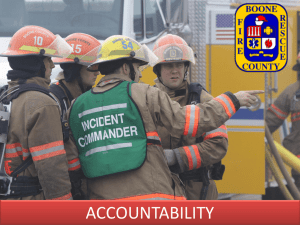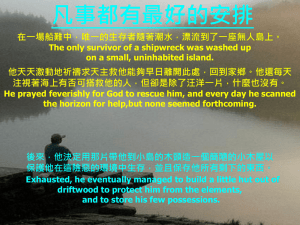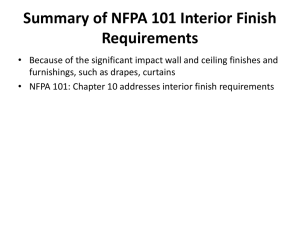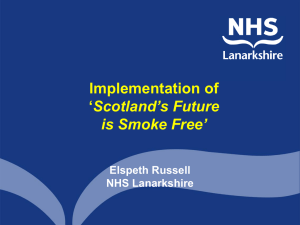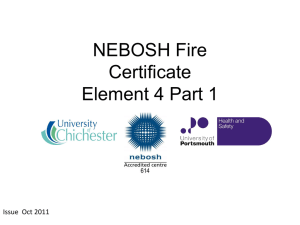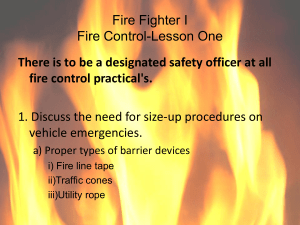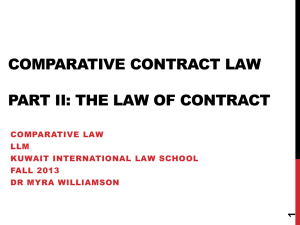Make a good SIZE-UP
advertisement
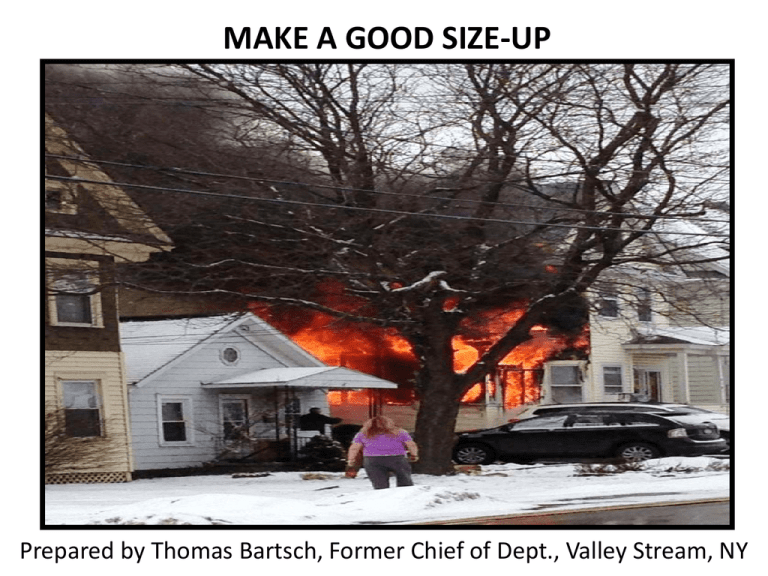
MAKE A GOOD SIZE-UP Prepared by Thomas Bartsch, Former Chief of Dept., Valley Stream, NY MAKE A GOOD SIZE-UP Introduction MAKE A GOOD SIZE-UP What is Size-Up? “Size-up is the ongoing observation and evaluation of factors that are used to develop strategic goals and tactical objectives”. MAKE A GOOD SIZE-UP There are many in the fire service who believe utilizing the traditional “13” point size-up to be lengthy and not practical for the initial “thru the windshield” size-up by the first arriving company officer, and is better suited for the Incident Commander. In most cases, the first arriving officer will not be the overall incident commander, but he/she might find themselves in command and the traditional “13” point size-up will help this officer develop a better over all picture of the incident. MAKE A GOOD SIZE-UP Yes, there are shorter “Size-Up” acronyms out there than the traditional “13” point “COAL WAS WEALTH” A sampling such as…………. BOSE HAS (Chief Walker, Oklahoma City FD, OK) B – building H - hazards O – occupancy A - approach S – smoke S - special E – exposures And then there are………….. MAKE A GOOD SIZE-UP BELOW (Former Chief of Dept Ed Tracy, Sierra Madre, CA) B - building E - extent L - life hazard O - occupancy W - water supply RECEO (Lloyd Layman) R - rescue E - exposures C - confinement E - extinguishment O - overhaul REVAS (Chief Ramirez, LACFD) R - rescue E - exposures V - ventilation A - attack S - salvage RECEO VS (Lloyd Layman) added were V - ventilate S - salvage MAKE A GOOD SIZE-UP And lastly, IDEAL (Capt Knitter, S. Milwaukee FD) I - indentify arriving unit D - describe what you see E - explain what you intend to do A - assume command L - let incoming units know what you want them to do or where you want them to go (staging, etc.) MAKE A GOOD SIZE-UP Whatever acronym you use, the goal is; o information gathering, o to formulate strategy and o successful tactics. This presentation will be focusing on the traditional “13” point size-up, using the acronym “COAL WAS WEALTH”. (aka WALLACE WAS HOT) MAKE A GOOD SIZE-UP SIZE-UP MAKE A GOOD SIZE-UP Size-Up by the initial arriving officer (IC until relieved), can set the tone for the incident. Being able to read what has happened and what will happen after arrival, effects the safety of all FF’s on the scene. A thorough Size-Up and a risk analysis should be performed before conducting operations at every incident. ₒ The IC should immediately conduct or obtain a 360 Size-Up of the fire ground. (“Rules of Engagement for Structural Firefighting”, International Association of Fire Chiefs) MAKE A GOOD SIZE-UP The IC is constantly evaluating, taking note of what actions were taken before his/her arrival and the progress of the fire. The IC continues to review and re-evaluate during fire operations. The IC must use appropriate risk management to decide what strategy will be employed. MAKE A GOOD SIZE-UP Size-Up starts with the receipt of the alarm and continues until the fire is under control. Some advocate the size-up starts when they break ground to construct and pre-plans are formulated. While responding, monitor your radio for up to the minute information from dispatch or from units already at the scene. Using the traditional strategic “13” point size-up acronym “COAL WAS WEALTH”, will ease the gathering of information to plan an effective Strategy. MAKE A GOOD SIZE-UP First Arriving Officer MAKE A GOOD SIZE-UP Among the most important duties of the first officer on the scene is conducting an initial size-up. This information lays the foundation for the entire operation. It determines the number of FF, apparatus and equipment needed to control the fire, the most effective point of attack and whether the attack will be offensive or defensive. The size-up must also address an assessment of “Risk versus Reward” MAKE A GOOD SIZE-UP The initial size-up report to dispatch, should be simple and short enough to verbalize the scene. Necessary details such as; what type of building is on fire? the type of occupancy (mercantile, residential, assembly) fire and smoke conditions and exposures (exposure protection is second only to life) Your report will give other responding units needed information to visualize the unfolding scene. MAKE A GOOD SIZE-UP Let’s try using an example. You are the first officer to arrive on scene, what initial size-up report will you give for the following situation? Remember, simple and verbalize the scene. Building construction Occupancy type Location and Extent of the fire Actions you are taking Instructions for incoming units MAKE A GOOD SIZE-UP This is your view “thru the windshield” Photo courtesy Ed Tracy, former Chief of Dept., Sierra Madre, CA MAKE A GOOD SIZE-UP Example: “Fire Communications, Engine 342, Signal 22 (On scene) at your address. Signal 10 (Working fire). We have fire out two windows on the second floor, exposure 1 (alpha) side, of a two story Ordinary constructed building with a mixed occupancy. We are stretching a line to the fire floor, have the second due engine stretch a backup line. Instruct the first due truck to ladder the building and inform them there are overhead wires.” MAKE A GOOD SIZE-UP Interior Size-Up MAKE A GOOD SIZE-UP The size-up of interior conditions is just as important as the exterior size-up. Interior conditions are monitored by firefighters and company officers and is communicated to the IC as soon as possible. Interior conditions could change the IC initial strategy. Knowing the interior conditions, such as the size of the fire, sets the foundation for subsequent operations. MAKE A GOOD SIZE-UP Especially if the building is constructed of lightweight framing, which must be suspected in newer and renovated buildings. It is critical that all units are made aware that lightweight construction is present. Strategy and tactics will have to be adjusted if the fire involves the structural components. The IC must be informed of any structural damage, such as sagging floors and extension to structural components. MAKE A GOOD SIZE-UP Communications MAKE A GOOD SIZE-UP Provide reports and regular updates to the IC, especially when goals are met, such as “we have water on the fire”. It is also important that interior forces communicate to the IC when the objective can not be met or is delayed, such as “we are having difficulty finding the fire”, or “primary search is delayed due to Collyer like conditions”. Communications during the fire attack may be difficult due to the noise, but FF must monitor the radio for critical information. (collapse potential, ventilation delays, water supply problems, fire in the cockloft, fire in the shaft or “Mayday” transmissions.) MAKE A GOOD SIZE-UP Information is continually received and processed so that new decisions can be made and old decisions revised based on new data and information. The IC can never assume that units engaged in operational activities will just naturally stop what they are doing so they can provide him/her with a continuous supply of information. MAKE A GOOD SIZE-UP If the IC requests a progress report from a unit and gets no response, he/she should continue to make contact until they get a satisfactory report. The IC must do whatever is required to stay effectively informed. Communicate what the plan is and if it is working….. MAKE A GOOD SIZE-UP Objectives MAKE A GOOD SIZE-UP The objective of firefighting is life safety, incident stabilization and property conservation. Implementation of any strategic plan and it’s supporting tactics is dependent on an accurate and ongoing Size-Up. Strategy and Tactics are defined as: • Strategy - the general plan or course of action in order to achieve firefighting objectives. • Tactics - the operations or actions required to carry out the strategy. (interior attack, ventilation, forcible entry, etc.) MAKE A GOOD SIZE-UP In his book, “Strategic Concepts of Firefighting”, Chief of Dept. Edward McAniff, FDNY defines the following; Offensive Strategy: Direct attack at the seat of fire. Normally at Incipient Stage, this solves all problems. Offensive/Defensive Strategy: An attack on the main body of fire, while taking measures to control extension. Defensive/Offensive Strategy: A holding action, it keeps fire in reasonable bounds while more forces are called. Defensive Strategy: Surround and drown, protect the exposures. MAKE A GOOD SIZE-UP Firefighting strategies have been changing in today’s fire service. With the impact of lightweight construction upon FF safety, a new strategy is evolving, “Offensive Exterior Attack”. It is used when no immediate rescue is needed or possible, and/or when there is fire involvement of the lightweight structural supports. Especially when a lightweight building is under construction. MAKE A GOOD SIZE-UP The time frame for safe operations has decreased. Once with unprotected dimensional lumber, there was the 20 minute rule, now with unprotected lightweight construction, the time is as little as 5 minutes to collapse. The “Offensive Exterior Attack” theory is to open up the structure and apply water tactically to gain control of the fire and extinguish from a safe position, due to the uncertainty of the structure. Essentially, “knock it down from a safe position and after verifying structural conditions are stable enough to proceed, final extinguishment and searches can be done.” MAKE A GOOD SIZE-UP COAL WAS WEALTH MAKE A GOOD SIZE-UP The Strategic factors that must be considered in making your size-up are; (not in the order of priority) • Construction • Occupancy • Apparatus/personnel/equipment • Life • Water Supply • Auxiliary appliances • Street conditions and Topography • Weather • Exposures • Area of the building • Location and Extent of the fire • Time • Height COAL WAS WEALTH MAKE A GOOD SIZE-UP COAL WAS WEALTH • Construction, type of; (construction dictates actions at all fires) - Type 1, Fire Resistive (concrete, fire-protected steel) - Type 2, Non-Combustible (little or no steel protection) - Type 3, Ordinary (block/brick walls, wood floor joists & roof supports) - Type 4, Heavy Timber (masonry load walls, large timber support) - Type 5, Wood Frame (balloon and platform) (Lightweight construction, manufactured homes and “unitized” truss) MAKE A GOOD SIZE-UP COAL WAS WEALTH Buildings will contain voids that may allow fire extension. Alterations may produce larger voids, which will spread fire vertically and horizontally. Also the presence of wood laminate “I” beams, “Unitized” truss, energy efficient windows, insulation, etc.. Information on the structure itself includes age, condition (evidence of deterioration, weathering, etc.), evidence of renovations, lightweight construction, loads on roofs and walls, and any pre-plan information. MAKE A GOOD SIZE-UP COAL WAS WEALTH • Construction; Elements of concern: is the building compartmentalized to minimize the spread of fire? how will the building contribute to the overall fire scenario? the location and number of hidden voids? what is the potential for collapse? parapet walls, marquees, signs, roof fixtures, etc., that could lead to a collapse in a fire event. MAKE A GOOD SIZE-UP COAL WAS WEALTH • Occupancy; (may determine severity of life & the intensity of the fire*) - Assembly (theatres, restaurants, house of worship, night clubs) - Business (banks, post office, doctors, lawyers, colleges, town halls) - Educational (schools thru 12th grade) - Factory (assembling, fabricating, finishing, manufacturing, etc.) - High Hazard (flammable, combustible, corrosive, explosive) * A mixed occupancy building containing commercial use below and a residential use above, with an increased fire load in the commercial, would increase the danger to residents above. MAKE A GOOD SIZE-UP COAL WAS WEALTH • Occupancy; (may determine severity of life & the intensity of the fire) - Institutional (hospitals, jails, nursing homes, assisted living) - Mercantile (drug, retail, wholesale stores) - Residential (hotels, motels, apartment houses, private dwellings) - Storage (non-hazard warehouses) - Utility and Miscellaneous (barns, green houses, sheds) MAKE A GOOD SIZE-UP COAL WAS WEALTH • Apparatus/Personnel/Equipment; Apparatus: - adequacy of responding units (pumpers, ladders, tankers, etc.) - response time (re-flex time and availability of mutual aid) - any changes in response patterns - the need for large caliber streams and/or large diameter hose - staging (location, enough units, security) What units are responding or on scene? It is imperative to know who has arrived and who is responding, as well the types of apparatus at the scene or requested to the scene. MAKE A GOOD SIZE-UP COAL WAS WEALTH • Apparatus/Personnel/Equipment; Personnel: - sufficient FF manpower* (greater or resound the alarm, mutual aid) - rehab (Red Cross, Salvation Army, Ladies Auxiliary) - Safety Officer - FAST/RIT/RIC unit(s) - EMS (ALS & BLS) - other agencies (Health, PD, Sanitation, Highway) * With insufficient manpower, rescue takes precedence. MAKE A GOOD SIZE-UP COAL WAS WEALTH • Apparatus/Personnel/Equipment; Equipment: - to handle hazard materials - foam, Purple K - medical - positive pressure fans - scene flood lighting - extra SCBA tanks - heavy machinery (bulldozers, payloaders, cranes) MAKE A GOOD SIZE-UP COAL WAS WEALTH • Life; OUR PRIMARY priority at any operation! - both FF’s and occupants (how many, location, condition, accessibility, available resources) - residential occupancy (day time versus night time) - commercial occupancy (day time versus night time) - institutional occupancy (ambulatory or non-ambulatory) - assembly occupancy (houses of worship, restaurants, arenas, large crowds) - vacant (risk?) “Don’t risk FF’s lives for what is already lost. Use a Calculated risk of FF’s lives to protect Savable lives.” “Rules of Engagement for Structural Firefighting” IAFC MAKE A GOOD SIZE-UP COAL WAS WEALTH • Water supply; - availability of a positive water source - the location, serviceability and is it sufficient - hydrants (the pressure, spacing, is it a dry or dead-end hydrant) - tanks, ponds, pools and cisterns - tanker shuttles - drafting MAKE A GOOD SIZE-UP COAL WAS WEALTH • Auxiliary Appliances; - sprinkler systems and standpipe systems - wet and dry chemical systems - total flooding systems, (Halon, CO2, Nitrogen) - fire pumps - foam systems Consider; what is the status of the system(s)? is it working automatically? can it be manually operated? The location of shut-off valves? are there FD connections? and there location? MAKE A GOOD SIZE-UP COAL WAS WEALTH • Street conditions and Topography; Street conditions: - placement of apparatus - overhead wires, elevated roads, railways - snow, water conditions - construction trenches, road repaving - double parked cars, delivery trucks - dead ends, narrow streets - limited access (industrial parks, gated communities) MAKE A GOOD SIZE-UP COAL WAS WEALTH • Street conditions and Topography; Topography: - grade elevation, building set backs (ground ladder and aerial ladder placement difficulty) - steepness of the slope (ladder placement) - is there a creek, pond, or river behind the building Note: There are some buildings where the lobby is on one floor and at the rear of the building, this level is higher or lower. As an example…… Two California FF died while operating at this structure – NIOSH 2011-13 report TOPOGRAPHY Two California FF died while operating at this structure – NIOSH 2011-13 report Severe topography situation, the fire floor was one floor below street level MAKE A GOOD SIZE-UP COAL WAS WEALTH • Weather conditions; - weather conditions can hamper response - wind/velocity/direction (wind impacted fire, convection carrying embers) - heat and humidity (heat exhaustion, heat stroke) - snow accumulations (slower response, hinder ladder placement) - wet and ice conditions (black ice, slower response) - freezing temperature ( wind chill, hypothermia, mechanical issues, frozen hydrants) MAKE A GOOD SIZE-UP COAL WAS WEALTH • Exposures; - distance (nearer the exposure, a greater chance of fire, convection and radiant heat) - six sides of a fire, (room and building) - most severely threatened versus most threatened life exposure - property and environment conservation - exposed surface material (it’s combustibility) - other exposures such as storage tanks (propane) Convection, Conduction and Radiation MAKE A GOOD SIZE-UP Exposure #2 or Bravo side Exposure #1 or Alpha side EXPOSURES Exposure #3 or Charlie side Exposure #4 or Delta side MAKE A GOOD SIZE-UP COAL WAS WEALTH • Area of the building; - large area = long stretches - size of the attack lines - large volume of fire = heavy smoke and heat - search lines, thermal imaging cameras - does the building have smoke vents? (automatic, manual, melt type) MAKE A GOOD SIZE-UP COAL WAS WEALTH • Location and Extent of the fire; - can determine what overall tactics are used - what is burning?, how long has it been burning? where is it going?, how fast will it get there? - location within the building or property; • cellar, basement, top floor, cockloft, shaft, compactor, ducts, voids. - fire impact on the building; • collapse (length of time the fire has been burning) - color of the smoke; • stage of heating. MAKE A GOOD SIZE-UP COAL WAS WEALTH Location – 2nd floor Extent – fully involved Photo courtesy of Ed Tracy, Former Chief of Dept., Sierra Madre, CA MAKE A GOOD SIZE-UP COAL WAS WEALTH • Time of the Day, Day of the Week, Time of the Year; (the IC must consider time when calculating the life hazard) - occupants sleeping at night (time of day) - rush hour traffic, (time of day) - holiday shopping (time of year) - religious holidays (time of year) - historic dates or anniversaries* (time of year) - occupant load (time of day, day of week, time of year) - limited visibility at night (time of day) - re-flex time mutual aid (time recognized/request until operational) *Historic dates or anniversaries could be a previous terrorist attack or politically significant dates. (such as 9/11, Oklahoma City, Waco Texas, Iraq and/or Afghanistan wars) MAKE A GOOD SIZE-UP COAL WAS WEALTH • Height of the building; - building access, egress, exterior rescue operations - High-Rise, (stack effect, control of HVAC) - elevator operations - standpipe operations - fire escape stretches - long stretches - possible areas of refuge - aerial/tower ladders (do you have them?, beyond your reach?) MAKE A GOOD SIZE-UP SMOKE MAKE A GOOD SIZE-UP Battalion Chief Dave Dodson in his presentation “The Art of Reading Smoke”, states; “All personnel arriving on scene have a responsibility to size-up the building, this includes reading smoke to determine what is burning, where it is burning, how long it’s been burning and how hot it is burning.” “FF’s must examine the smoke carefully. The decision to enter or exit the structure, is based in part of these characteristics of smoke, volume, velocity, density and color.” MAKE A GOOD SIZE-UP Smoke issuing from the structure tells a lot about what the fire is going to do. Smoke is a combustible gas that can indicate the type of fire and volume. Smoke can lead to a rollover, flashover or even a backdraft. * It should be noted here that modern building contents involve hydrocarbon and synthetic based material such as foam rubber, nylon, rayon and polypropylene. MAKE A GOOD SIZE-UP * A recent UL research project “Impact of Ventilation” on modern content fires, disclosed that “a common event during the experiments was that once the fire became ventilation limited, the smoke being forced out of the gaps of the houses greatly diminished or stopped all together.” * “No smoke showing during size-up should increase awareness of the potential conditions inside.” * “Once the front door is opened, attention should be given to the flow through the door. A rapid in-rush of air or a tunneling effect could indicate a ventilation limited fire.” MAKE A GOOD SIZE-UP • Volume of smoke: relative to the size of the building, light smoke from a large building can be deceptive; - smoke volume is an indicator of the amount of fuels that are “off-gassing” within a specified space. - can establish relativity about the size of the fire. - it would not take much fire to fill a 1200 square foot dwelling with smoke, but it would take considerable fire to show a small amount of smoke coming from Macy’s or a Sears. MAKE A GOOD SIZE-UP Looking at the Volume of smoke coming from this structure, what are you facing? A lot of fuel “offgassing”, large fire MAKE A GOOD SIZE-UP • Velocity of smoke (Pressure): Only two things can create smoke pressure, 1. heat and 2. restricting the volume of smoke within a room or building; - velocity is an indicator of pressure built up within. - volume pushed smoke will slow down right away and will likely sink when it moves outside. - heat pushed smoke will leave the building and gradually slow as the smoke rises. MAKE A GOOD SIZE-UP • Velocity of smoke (Pressure): - if the smoke is smooth or calm (also referred as Laminar), the building is absorbing more heat. - if the smoke is turbulent (rolling/boiling), a flashover is likely to occur. MAKE A GOOD SIZE-UP How fast the smoke is leaving can indicate the volume or heat and helps find the location of the fire. The faster the smoke, the closer the fire, Velocity Turbulent smoke leaving the front Laminar smoke in the rear Where is the main body of fire? MAKE A GOOD SIZE-UP • Density of smoke: Incomplete combustion causes smoke to thicken and become dense; - smoke density is indicative of the amount of fuel that is laden within the smoke. - the thicker the smoke, the more fuel there is available to burn. - the more fuel available to burn, the more likely to have a flashover. MAKE A GOOD SIZE-UP • Density of smoke: - dense smoke has the ability to “light-off” at any given time. - for FF safety, remember………….. “DENSE SMOKE UNDER HIGH VELOSITY IS A NO GO!!!!” MAKE A GOOD SIZE-UP The Density of smoke indicates the quality of burning, the continuity of fuel, and the likelihood and degree of an outcome. Looking at the density of this smoke, what do you think will happen? FLASHOVER MAKE A GOOD SIZE-UP • Color of smoke: - reading of smoke is essential to the outcome of the incident. - smoke color is not predictable to what is burning, unless it is a single fuel fire. - fire location. - tan or brown smoke, natural materials. MAKE A GOOD SIZE-UP • Color of smoke: - plastics and painted surfaces appear to be grey. - the darker the smoke, the hotter it is. - black smoke can appear grey when mixed with moisture from other heated materials. MAKE A GOOD SIZE-UP As smoke travels throughout a building, carbon content is left along walls and contents, causing the smoke to be filtered and can lighten the smoke Color. Therefore, white or light smoke should never be overlooked ! MAKE A GOOD SIZE-UP The amount of smoke movement is also an indicator of temperature. - Twisting, boiling smoke which rises very rapidly, is very hot. - Lazy (Laminar), drifting smoke is not. If heavy smoke is showing from the entire building, but you see no visible fire, expect a cellar/basement fire. Take a quick look at the chimney to verify this. Even during the heating season, a normal oil or gas burner does not send large amounts of smoke up a chimney, but a working cellar/basement fire can. MAKE A GOOD SIZE-UP Yesterday vs. Today Air tight structures may not leak any smoke White ringed black smoke Exterior walls (well insulated) not hot Thick black smoke will likely obscure any flame Thermopane windows are glued in – won’t rattle Thermopane windows will not conduct heat to outer pane 72 MAKE A GOOD SIZE-UP Do Your 3600 Size-UP MAKE A GOOD SIZE-UP Looking at the fire from this position Looks like fire on 2nd and the top floor Do Your 3600 Size-Up Photo by permission of The Firefighters Support Foundation MAKE A GOOD SIZE-UP A whole new perspective on this side, with an exposure problem But from this position! Do Your 3600 Size-Up Photo by permission of The Firefighters Support Foundation MAKE A GOOD SIZE-UP Remember, Size-Up starts with the receipt of the alarm; - where am I going? - what type of structure and occupancy? - what units are responding or on scene? - monitor the radio for additional information from dispatch, (numerous calls, people trapped, people on the fire escape) MAKE A GOOD SIZE-UP Remember, Size-Up starts with the receipt of the alarm; - listen to the Initial size-up by first arriving officer, Is the Officer Excited? - where is the fire located? - what is being done? MAKE A GOOD SIZE-UP Upon arrival, perform or obtain a “ 360” size-up around the perimeter of the building for a visual of the affected area and the surrounding properties. Assess the situation for the following information: - existing conditions and the actions taken (Offensive , Offensive–Defensive, Defensive-Offensive, Defensive Strategy or Offensive Exterior Attack) - the location and extent of the fire (what’s burning?, where is it going?, how fast will it get there? How long has it been burning?) MAKE A GOOD SIZE-UP Assessment continued: - the known and possible life hazards and the progress of the searches (Primary and Secondary) - the location of units present and where are they operating - is positive water supply established? - what type of construction (buildings age, evidence of deterioration, weathering, lightweight construction) MAKE A GOOD SIZE-UP Assessment continued: - any unique features? (parapet walls, marquees, signs, and roof fixtures that could lead to a collapse, metal roofs, solar panels, cell antennas) - are there fire escapes present? (stretching of hoselines) - are there alternate entrance doors at the sides and/or the rear? - is the rear accessible? MAKE A GOOD SIZE-UP Assessment continued: - are there security gates, window bars or any inaccessible window/door conditions? - as units arrive, assign specific tasks or stage them - is there a need for apparatus re-positioning? - how well are portable ladders positioned? MAKE A GOOD SIZE-UP Assessment continued: - what is the location of operating hoselines? (need to be re-positioned, additional lines needed?) - how are operations progressing? (should units be redeployed, are additional units needed?) - what are the fire, heat and smoke conditions? (additional alarms or Mutual Aid?) - has fire extended within the building? - what type and location of interior stairs? (Scissor, spiral) MAKE A GOOD SIZE-UP Assessment continued: - any extension into the exposures? (Immediate or potential problems?) - topography? - FAST/RIT/RIC unit(s) designated and on scene? - Safety Officer designated and on scene? - radio channel frequencies of operating units and Command MAKE A GOOD SIZE-UP Assessment continued: - Incident Command Post (ICP) - staging (location, security) The ICP should be established in proximity to the front of the building, close enough to maintain radio communications with the operating units but outside of the collapse zone and far enough away to be able to properly size-up the situation. If possible, able to view two sides of the building MAKE A GOOD SIZE-UP Incident Command Post MAKE A GOOD SIZE-UP “The IC shall have overall authority for the management of the incident”, (NFPA 1561 “Standard on Emergency Services Incident Management System”, §5.3.1) The IC must establish and maintain a command post outside of the structure to assign companies and delegate functions, continually evaluate the risk versus gain of continued fire fighting efforts. (NFPA 1561) This process includes initiating the tactical worksheet, and starting the personnel accounting system. (NFPA 1561) MAKE A GOOD SIZE-UP In establishing a command post (ICP), the IC shall ensure the following; (NFPA 1561) • The ICP is located in or tied to a vehicle to establish presence and visibility. • The ICP includes radio capability to monitor and communicate with assigned tactical operations, command, and designated traffic channels for the incident. MAKE A GOOD SIZE-UP In establishing a command post (ICP), the IC shall ensure the following; (NFPA 1561) • The location of the ICP is communicated to the dispatch center. • The IC, or his/her designee, is present at the command post. • The ICP should be located in the incident cold zone. MAKE A GOOD SIZE-UP Exposure #2 or Bravo side Exposure #3 or Charlie side Exposure #1 or Alpha side Exposure #4 or Delta side COMMAND POST (able to see two sides of the building and outside of the collapse zone) MAKE A GOOD SIZE-UP Practice Scenario MAKE A GOOD SIZE-UP Many of the traditional “13” size-up points you might be able to answer while responding, by knowing your district. An alarm is transmitted for a part of your town that you know is all private residential homes, you already have some knowledge of the; - Construction (type 5 wood frame) - Occupancy (private residential) - Apparatus/personnel/equipment (Unknown yet) - Life (what time is the alarm?, residents awake or sleeping) - Water (hydrants or tankers) - Auxiliary Appliances (probably not) - Street conditions/Topography (overhead wires) MAKE A GOOD SIZE-UP - Street Conditions/Topography (level grade) - Weather (you are out in it, snow, rain, wind) - Exposures (due to zoning laws, min lot sizes, i.e. 40’x100’) - Area of the building (private dwelling, building 25’ x 40’) - Location and Extent of the fire (Unknown yet) - Time (residents awake/sleeping, your FD response) - Height (most private dwellings 1 or 2 stories) As by this example, you already possess information that addresses “11” of the “13” points of a Size-Up. MAKE A GOOD SIZE-UP Summary MAKE A GOOD SIZE-UP Remember Size-Up starts with the receipt of the alarm and continues until the fire is under control. Do your 3600 Size-Up, as the fire progresses, so will your size-up. Get as much information as possible. Pre-plans play a huge role before and during size-up. Always be concerned with lightweight construction and it’s presence must be reported to the IC and to all units. MAKE A GOOD SIZE-UP Communicate, Communicate, Communicate “Risk versus Reward” • Risk a lot to save a lot (savable lives). • Risk little to save little (savable property). • Risk nothing to save nothing (lives/property already lost). “EVERYBODY GOES HOME” MAKE A GOOD SIZE-UP A special Thank You to the following for their comments and suggestions in the preparation of this presentation. A friend for more than forty years, Ed Tracy, former Chief of Dept, Sierra Madre, CA., And Dave Walsh, Program Chair, Dept of Fire Science, Dutchess County Community College, Poughkeepsie, NY MAKE A GOOD SIZE-UP THANK YOU ANY QUESTIONS?
